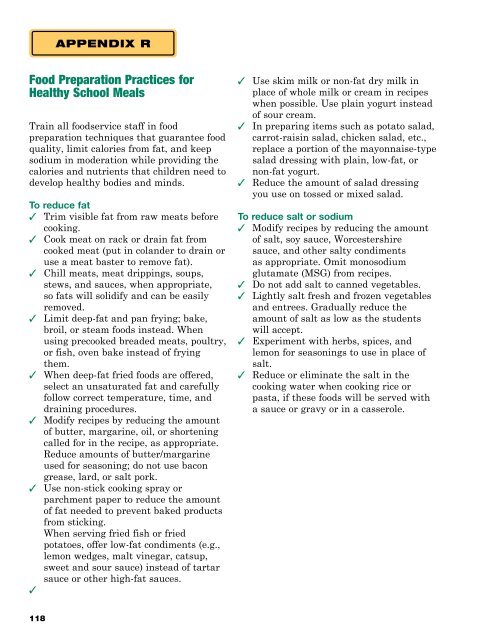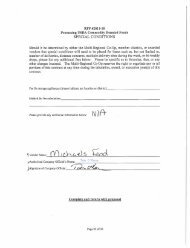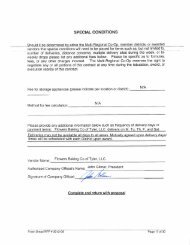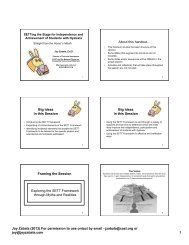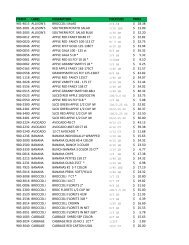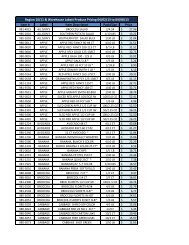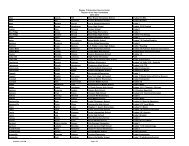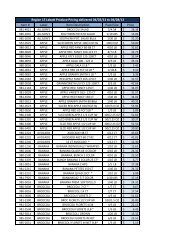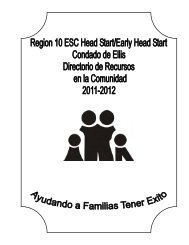Road to SMI Success Manual - Region 10 Education Service Center
Road to SMI Success Manual - Region 10 Education Service Center
Road to SMI Success Manual - Region 10 Education Service Center
You also want an ePaper? Increase the reach of your titles
YUMPU automatically turns print PDFs into web optimized ePapers that Google loves.
Appendix R<br />
Food Preparation Practices for<br />
Healthy School Meals<br />
Train all foodservice staff in food<br />
preparation techniques that guarantee food<br />
quality, limit calories from fat, and keep<br />
sodium in moderation while providing the<br />
calories and nutrients that children need <strong>to</strong><br />
develop healthy bodies and minds.<br />
To reduce fat<br />
✓ Trim visible fat from raw meats before<br />
cooking.<br />
✓ Cook meat on rack or drain fat from<br />
cooked meat (put in colander <strong>to</strong> drain or<br />
use a meat baster <strong>to</strong> remove fat).<br />
✓ Chill meats, meat drippings, soups,<br />
stews, and sauces, when appropriate,<br />
so fats will solidify and can be easily<br />
removed.<br />
✓ Limit deep-fat and pan frying; bake,<br />
broil, or steam foods instead. When<br />
using precooked breaded meats, poultry,<br />
or fish, oven bake instead of frying<br />
them.<br />
✓ When deep-fat fried foods are offered,<br />
select an unsaturated fat and carefully<br />
follow correct temperature, time, and<br />
draining procedures.<br />
✓ Modify recipes by reducing the amount<br />
of butter, margarine, oil, or shortening<br />
called for in the recipe, as appropriate.<br />
Reduce amounts of butter/margarine<br />
used for seasoning; do not use bacon<br />
grease, lard, or salt pork.<br />
✓ Use non-stick cooking spray or<br />
parchment paper <strong>to</strong> reduce the amount<br />
of fat needed <strong>to</strong> prevent baked products<br />
from sticking.<br />
When serving fried fish or fried<br />
pota<strong>to</strong>es, offer low-fat condiments (e.g.,<br />
lemon wedges, malt vinegar, catsup,<br />
sweet and sour sauce) instead of tartar<br />
sauce or other high-fat sauces.<br />
✓<br />
✓<br />
✓<br />
✓<br />
Use skim milk or non-fat dry milk in<br />
place of whole milk or cream in recipes<br />
when possible. Use plain yogurt instead<br />
of sour cream.<br />
In preparing items such as pota<strong>to</strong> salad,<br />
carrot-raisin salad, chicken salad, etc.,<br />
replace a portion of the mayonnaise-type<br />
salad dressing with plain, low-fat, or<br />
non-fat yogurt.<br />
Reduce the amount of salad dressing<br />
you use on <strong>to</strong>ssed or mixed salad.<br />
To reduce salt or sodium<br />
✓ Modify recipes by reducing the amount<br />
of salt, soy sauce, Worcestershire<br />
sauce, and other salty condiments<br />
as appropriate. Omit monosodium<br />
glutamate (MSG) from recipes.<br />
✓ Do not add salt <strong>to</strong> canned vegetables.<br />
✓ Lightly salt fresh and frozen vegetables<br />
and entrees. Gradually reduce the<br />
amount of salt as low as the students<br />
will accept.<br />
✓ Experiment with herbs, spices, and<br />
lemon for seasonings <strong>to</strong> use in place of<br />
salt.<br />
✓ Reduce or eliminate the salt in the<br />
cooking water when cooking rice or<br />
pasta, if these foods will be served with<br />
a sauce or gravy or in a casserole.<br />
118


